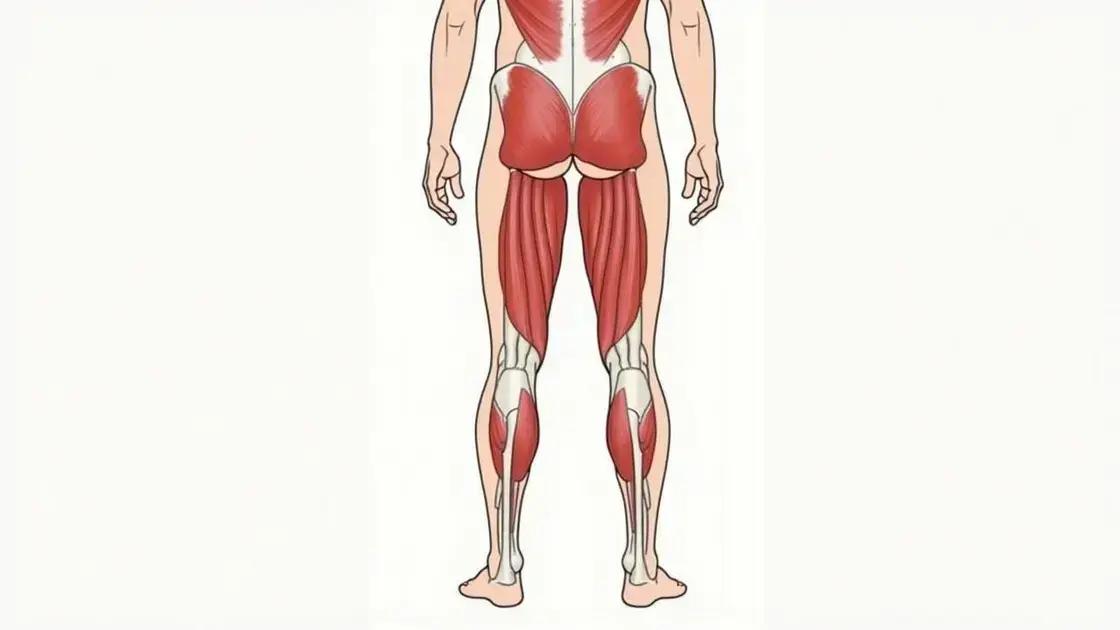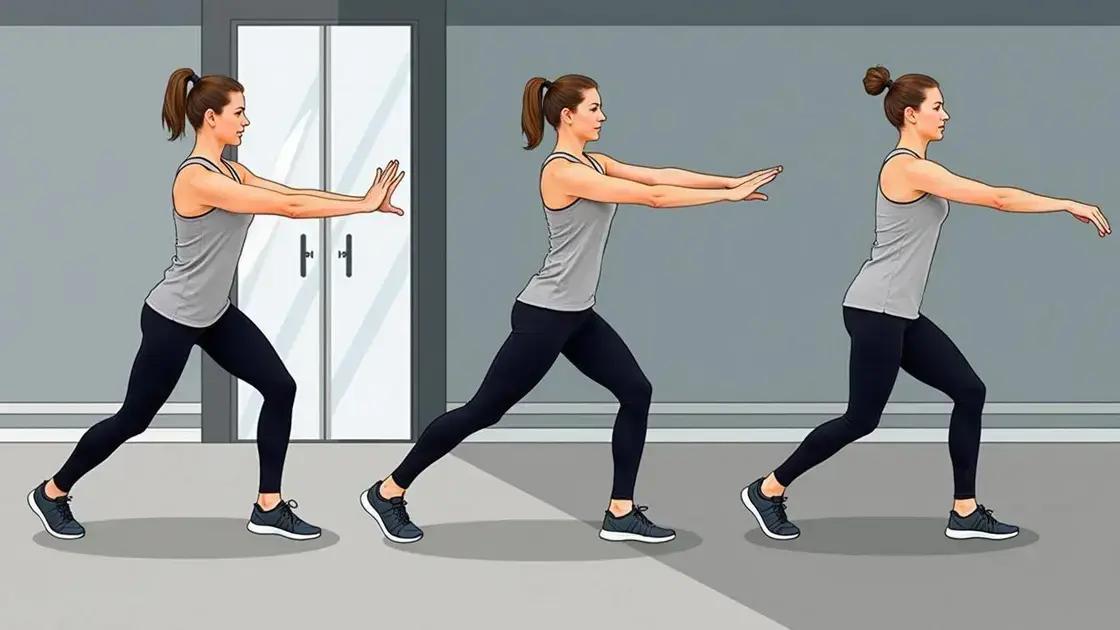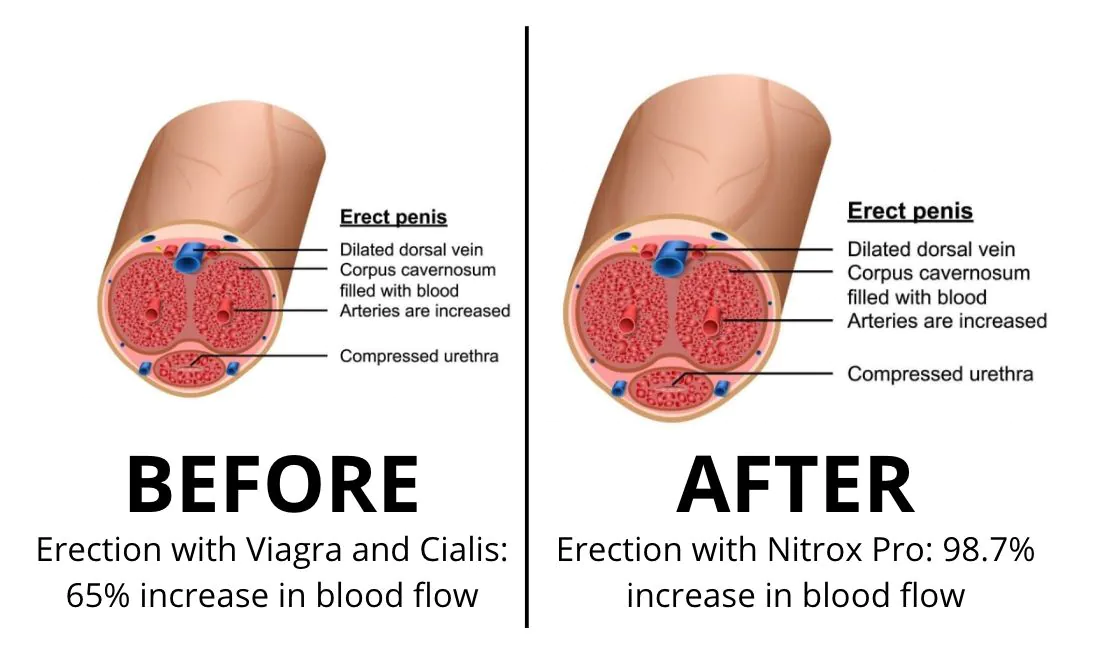To improve hamstring flexibility with dynamic stretches, incorporate effective movements like leg swings, walking lunges, high knees, and butt kicks into your routine, ideally before workouts to enhance performance and minimize injury risk.
Improving hamstring flexibility with dynamic stretches is essential for athletes and active individuals. Enhancing flexibility promotes better performance, reduces injury risks, and contributes to overall physical health. In this post, we will delve into understanding what hamstring flexibility entails, explore the numerous benefits of dynamic stretching, and present effective stretches to incorporate into your routine.
Understanding Hamstring Flexibility

Understanding hamstring flexibility is vital for anyone looking to improve their athletic performance or avoid injuries. Hamstring flexibility refers to the range of motion in the muscles located at the back of your thigh. These muscles play a vital role in movement, especially during activities like running, jumping, and squatting.
A well-stretched hamstring helps enhance posture and can lead to a more efficient stride, whether you’re jogging or sprinting. Low flexibility in this area can also result in tightness, which may affect your mobility and lead to discomfort in your lower back and knees.
The hamstrings consist of three primary muscles: biceps femoris, semitendinosus, and semimembranosus. Together, they connect the pelvis to the lower leg, and their flexibility varies between individuals based on factors like activity level, age, and muscle conditioning.
Factors such as a sedentary lifestyle, prolonged sitting, and lack of stretching can lead to decreased hamstring flexibility. Addressing these issues through effective techniques, especially dynamic stretches, is crucial.
Being aware of your current flexibility status is essential. Regular assessments can help you track your progress as you implement dynamic stretching routines into your workouts. A little time spent understanding your hamstring flexibility can go a long way in enhancing your overall performance.
Benefits of Dynamic Stretching

Dynamic stretching offers several benefits that can significantly improve athletic performance and overall fitness. Unlike static stretching, which involves holding a stretch, dynamic stretching engages your muscles and joints through movement. This form of stretching prepares the body for physical activity and can yield various advantages.
One key benefit is increased blood flow to the muscles. As you perform dynamic stretches, your heart rate rises, promoting circulation. This results in warmer muscles, which are less prone to injuries. A well-warmed-up muscle is more flexible and responsive.
Dynamic stretching also enhances range of motion. By actively moving your joints and muscles, you increase their flexibility and mobility, which may lead to improved athletic performance. Greater range of motion can make complex movements easier, benefiting activities such as running and jumping.
Additionally, dynamic stretching can improve muscle coordination. Engaging in dynamic movements encourages your body to work in a unified manner. This can help with balance and stability during sports and everyday activities.
Finally, using dynamic stretches can serve as an effective warm-up routine. These stretches activate various muscle groups, getting your body ready for more intense workouts. This preparation is crucial for optimizing performance and minimizing the risk of injury.
Effective Dynamic Stretches for Hamstrings

If you’re looking to improve hamstring flexibility, incorporating effective dynamic stretches into your routine is essential. Here are some of the best dynamic stretches to enhance this crucial muscle group:
1. Leg Swings: Stand next to a wall or support and swing one leg forward and backward. Keep your torso straight and your movements controlled. This stretch helps loosen the hamstrings and hips.
2. Walking Lunges with a Twist: Take a step forward into a lunge position, then twist your torso toward the front leg. Alternate legs as you move forward. This exercise stretches the hamstrings while also engaging your core.
3. High Knees: While jogging in place, lift your knees as high as possible toward your chest. This not only warms up your hamstrings but also increases heart rate and blood flow.
4. Butt Kicks: While standing or jogging in place, try to kick your heels up to your glutes. This dynamic stretch actively engages the hamstrings and warms them up effectively.
5. Frankenstein Walks: Walk forward while kicking one leg straight out in front of you, trying to touch your opposite hand with your toes. This stretch effectively targets the hamstrings while improving balance and coordination.
Incorporating these dynamic stretches into your warm-up routine can significantly improve hamstring flexibility and prepare your body for more intense workouts. Remember to perform these stretches in a controlled manner to maximize effectiveness and minimize the risk of injury.
Incorporating Dynamic Stretches into Your Routine

Incorporating dynamic stretches into your routine is key for improving hamstring flexibility and preparing your body for exercise. Here’s how you can effectively add these stretches to your workouts:
1. Warm-Up Before Every Workout: Start your sessions with dynamic stretches to get your blood flowing. Spend about 5 to 10 minutes on these movements. This helps activate your muscles and prepares your body for more intense activities.
2. Create a Stretching Sequence: Combine different dynamic stretches into a sequence. For example, start with leg swings, then move to walking lunges, followed by high knees. A flowing routine keeps your muscles engaged and ready.
3. Use Dynamic Stretching Between Sets: Instead of resting completely between sets, perform light dynamic stretches. This keeps your muscles active and maintains blood flow, reducing fatigue.
4. Schedule Stretching Days: Consider having days dedicated solely to flexibility training, including dynamic stretching. This allows for focused improvement and may accelerate progress in flexibility.
5. Listen to Your Body: Pay attention to how your muscles feel during dynamic stretches. If you experience pain, adjust your movements. Always prioritize safety to prevent injuries.
By incorporating these strategies, you’ll enhance your hamstring flexibility and overall performance. Dynamic stretching is an essential part of both warm-up and cool-down routines, making it beneficial for athletes and fitness enthusiasts alike.
In Summary: Enhance Your Hamstring Flexibility
Improving hamstring flexibility with dynamic stretches is crucial for athletes and anyone looking to enhance their physical performance. By understanding your hamstrings and the benefits of dynamic stretching, you can effectively incorporate these methods into your routine.
Utilizing effective dynamic stretches not only prepares your muscles for physical activity but also minimizes injury risks and improves overall mobility. Developing a consistent routine that includes these stretches can lead to better athletic performance and increased flexibility.
Always remember to listen to your body. By doing so, you’ll enjoy a safer and more effective stretching experience. With dedication and the right techniques, you can significantly improve your hamstring flexibility and achieve your fitness goals.
FAQ – Frequently Asked Questions about Improving Hamstring Flexibility with Dynamic Stretches
What are dynamic stretches?
Dynamic stretches are movements performed to warm up your muscles and increase flexibility through active motion, such as leg swings or walking lunges.
Why is hamstring flexibility important?
Hamstring flexibility is crucial for athletic performance, as it enhances movement efficiency, reduces injury risks, and improves overall mobility.
How often should I do dynamic stretches?
It is recommended to perform dynamic stretches before every workout or athletic activity to properly prepare your muscles and joints.
Can dynamic stretches replace static stretching?
Dynamic stretches are primarily for warming up, while static stretches are better suited for cooling down after workouts. Both have their place in a fitness routine.
How can I ensure I am doing dynamic stretches correctly?
Focus on controlled movements, maintain good form, and listen to your body. If you experience pain, adjust the stretch or consult a fitness professional.
What are some effective dynamic stretches for hamstrings?
Some effective dynamic stretches include leg swings, walking lunges with a twist, high knees, butt kicks, and Frankenstein walks.












